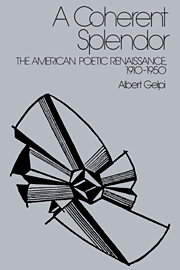Book contents
- Frontmatter
- Contents
- Acknowledgments
- Dedication
- Introduction. The Janus-Face of Romanticism and Modernism
- 1 Robert Frost and John Crowe Ransom: Diptych of Ironists, the Woodsman and the Chevalier
- 2 Wallace Stevens: World as Mundo, Mundo as World
- 3 T. S. Eliot: The Lady Between the Yew Trees
- 4 Ezra Pound: Between Kung and Elcusis
- 5 H. D.: Helen in Bethlehem, Hilda in Egypt
- 6 William Carlos Williams: Mother-Son and Paterson
- 7 Allen Tate and Hart Crane: Diptych with Angels and Demons
- Coda. Yvor Winters and Robinson Jeffers: The Janus-Face of Anti-Modernism
- Notes
- Index
1 - Robert Frost and John Crowe Ransom: Diptych of Ironists, the Woodsman and the Chevalier
Published online by Cambridge University Press: 22 January 2010
- Frontmatter
- Contents
- Acknowledgments
- Dedication
- Introduction. The Janus-Face of Romanticism and Modernism
- 1 Robert Frost and John Crowe Ransom: Diptych of Ironists, the Woodsman and the Chevalier
- 2 Wallace Stevens: World as Mundo, Mundo as World
- 3 T. S. Eliot: The Lady Between the Yew Trees
- 4 Ezra Pound: Between Kung and Elcusis
- 5 H. D.: Helen in Bethlehem, Hilda in Egypt
- 6 William Carlos Williams: Mother-Son and Paterson
- 7 Allen Tate and Hart Crane: Diptych with Angels and Demons
- Coda. Yvor Winters and Robinson Jeffers: The Janus-Face of Anti-Modernism
- Notes
- Index
Summary
The internationalist spirit of Modernism made its poets view Emerson and Poe, Whitman and Dickinson as quaint and provincial, in fact drew many of them – Pound, Eliot, H. D., Gertrude Stein – abroad to mingle with Old World expatriates like Joyce, Lawrence, Picasso, Stravinsky. Williams chose the local, but his locality allowed him to be part of the New York Vortex. Harriet Monroe's Poetry magazine was part of the Second City's attempt to prove itself a Midwestern Vortex, but Pound had grave doubts and Hart Crane gravitated from Ohio to the sophisticated New York scene rather than the Chicago Renaissance of Sandburg and Vachel Lindsay. So the calculated Yankee and southern regionalism, even provinciality, of Robert Frost and John Crowe Ransom represents as much an ideological and aesthetic stance as does the identification of Robinson Jeffers and Yvor Winters with California. The discussion of Frost and Ransom here and of Winters and Jeffers in the final chapter brackets and lends context to the consideration of the American Modernist poets in the body of the book.
Frost and Ransom, along with Stevens, seemed older in spirit than the others (though Ransom was in fact about the same age as Eliot and Pound). Ransom saw Frost as one of the poets who “are evidently influenced by modernism without caring to ‘go modern’ in the sense of joining the revolution,”.
- Type
- Chapter
- Information
- A Coherent SplendorThe American Poetic Renaissance, 1910–1950, pp. 8 - 48Publisher: Cambridge University PressPrint publication year: 1988



